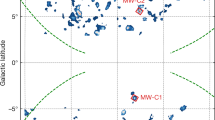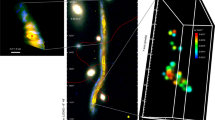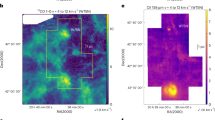Abstract
The Milky Way's halo contains clouds of neutral hydrogen with high radial velocities which do not follow the general rotational motion of the Galaxy1. Few distances to these high-velocity clouds are known2,3, so even gross properties such as total mass are hard to determine. As a consequence, there is no generally accepted theory regarding their origin. One idea4,5 is that they result from gas that has cooled after being ejected from the Galaxy through fountain-like flows powered by supernovae; another is that they are composed of gas, poor in heavy elements, which is falling onto the disk of the Milky Way from intergalactic space6,7. The presence of molecular hydrogen, whose formation generally requires the presence of dust (and therefore gas, enriched in heavy elements), could help to distinguish between these possibilities. Here we report the discovery of molecular hydrogen absorption in a high-velocity cloud along the line of sight to the Large Magellanic Cloud. We also derive for the same cloud an iron abundance which is half of the solar value. From these data, we conclude that gas in this cloud originated in the disk of the Milky Way.
This is a preview of subscription content, access via your institution
Access options
Subscribe to this journal
Receive 51 print issues and online access
$199.00 per year
only $3.90 per issue
Buy this article
- Purchase on Springer Link
- Instant access to full article PDF
Prices may be subject to local taxes which are calculated during checkout



Similar content being viewed by others
References
Wakker,B. Distribution and origin of high-velocity clouds. Astron. Astrophys. 250, 499–508 (1991).
Wakker,B. P. & van Woerden,H. High-velocity clouds. Annu. Rev. Astron. Astrophys. 35, 217–266 (1997).
van Woerden,H. et al. A confirmed location in the Galactic halo for the high-velocity cloud ‘chain A’. Nature 400, 138–141 (1999).
Shapiro,P. R. & Field,G. B. Consequences of a new hot component of the interstellar medium. Astrophys. J. 205, 762–765 (1976).
Bregman,J. N. The galactic fountain of high-velocity clouds. Astrophys. J. 236, 577–591 (1980).
Oort,J. H. The formation of galaxies and the origin of the high-velocity hydrogen. Astron. Astrophys. 7, 381–404 (1970).
Blitz,L. et al. High-velocity clouds: building blocks of the Local Group. Astrophys. J. 514, 818–843 (1999).
Wakker,B. P., Murphy,E. M., van Woerden, H. & Dame,T. M. A sensitive search for molecular gas in high-velocity clouds. Astrophys. J. 488, 216–223 (1997).
Akeson,R. L. & Blitz,L. A search for hydrogen and molecular gas absorption in high-velocity clouds. Astrophys. J. 523, 163–170 (1999).
Barnstedt,J. et al. The ORFEUS II Echelle Spectrometer: Instrument description, performance and data reduction. Astron. Astrophys. Suppl. 134, 561–567 (1999).
Savage,B. D. & de Boer,K. S. Ultraviolet absorption by interstellar gas at large distances from the Galactic plane. Astrophys. J. 243, 460–484 (1981).
Bomans,D. J., de Boer,K. S., Koornneef,J. & Grebel,E. K. CIV absorption from hot gas inside the supergiant shell LMC4 observed with HST and IUE. Astron. Astrophys. 313, 101–112 (1996).
de Boer,K. S., Morras,R. & Bajaja,E. The location of intermediate- and high-velocity gas in the general direction of the Large Magellanic Cloud. Astron. Astrophys. 233, 523–526 (1990).
McGee,R. X. & Newton,L. M. Neutral hydrogen in the Galactic halo. Proc. Astron. Soc. Aust. 6, 358–385 (1986).
Savage,B. D., Bohlin,R. C., Drake,J. F. & Budich,W. A survey of interstellar molecular hydrogen. Astrophys. J. 216, 291–307 (1977).
Spitzer,L. & Zweibel,E. G. On the theory of H2 rotational excitation. Astrophys. J. 191, L127–L130 (1974).
Burton,M. G., Hollenbach,D. J. & Thielens,A. G. G. M. Mid-infrared rotational line emission from interstellar molecular hydrogen. Astrophys. J. 399, 563–572 (1992).
Jura,M. A. Interstellar clouds containing optically thin H2. Astrophys. J. 197, 575–580 (1975).
Putman,M. E. & Gibson,B. K. First results from the Parkes Multibeam High-velocity Cloud Survey. Proc. Astron. Soc. Aust. 16, 70–76 (1999).
Grewing,M. & Schulz-Lüpertz,E. Ionisationsstrukturen im galaktischen Halogas. Mitt. Astron. Gesellsch. 52, 79–83 (1981).
de Boer,K. S., Jura,M. A. & Schull,J. M. Diffuse and dark clouds in the interstellar medium. Scientific Accomplishments of the IUE (ed. Kondo, Y.) 485–515 (Reidel, Dordrecht, 1987).
Pei,Y. C. & Fall,S. M. Cosmic chemical evolution. Astrophys. J. 454, 69–76 (1995).
Morton,D. C. & Dinerstein,H. L. Interstellar molecular hydrogen toward Zeta Puppis. Astrophys. J. 204, 1–11 (1975).
Field,G. B., Somerville,W. B. & Dressler,K. Hydrogen molecules in Astronomy. Annu. Rev. Astron. Astrophys. 4, 207–244 (1966).
Nichols, J. S. & Linsky,J. L. The Final Archive and recalibration of the International Ultraviolet Explorer (IUE) satellite. Astron. J. 111, 517–536 (1996).
Acknowledgements
We thank M. Putman and C. Brüns for providing part of the HIPASS data.
Author information
Authors and Affiliations
Corresponding author
Rights and permissions
About this article
Cite this article
Richter, P., de Boer, K., Widmann, H. et al. Discovery of molecular hydrogen in a high-velocity cloud of the Galactic halo. Nature 402, 386–387 (1999). https://doi.org/10.1038/46492
Received:
Accepted:
Issue Date:
DOI: https://doi.org/10.1038/46492
This article is cited by
-
Clouds from near and far
Nature (1999)
-
High speed clouds shed a few secrets
Nature (1999)
Comments
By submitting a comment you agree to abide by our Terms and Community Guidelines. If you find something abusive or that does not comply with our terms or guidelines please flag it as inappropriate.



